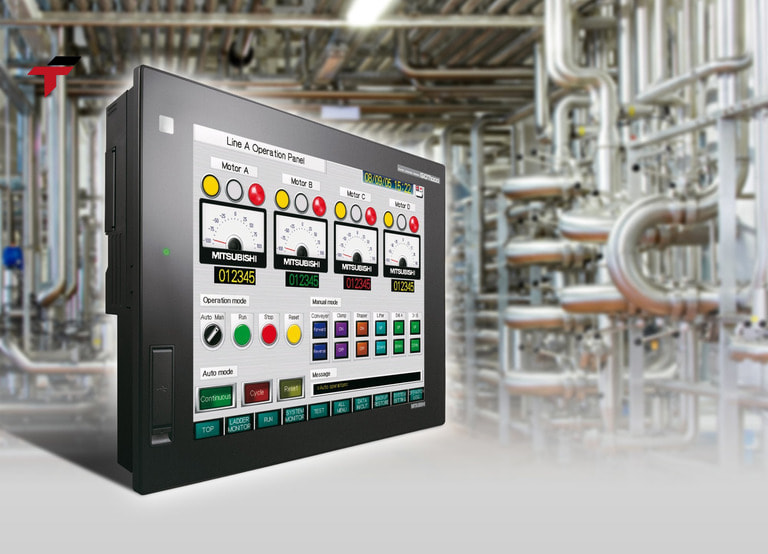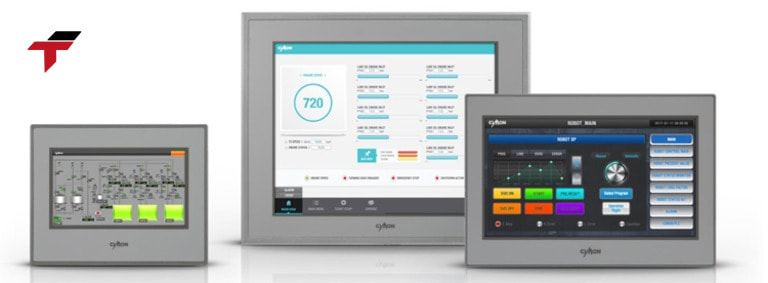For HMI to maintain stable communication with PLCs, SCADA, or other control devices, configuring the IP address correctly is essential. Incorrect or duplicated IP addresses are one of the most common causes of connection loss, leading to production interruptions and system downtime. In this article, Flextech shares practical guidance on how to set up an HMI IP address properly, along with key precautions and troubleshooting tips to ensure stable network communication in your automation systems.
What is IP Address in HMI?
In an automation network, every device needs a specific “address” to exchange data accurately — and that’s exactly what the IP Address (Internet Protocol Address) provides for an HMI.
The IP address serves as a unique digital identifier that allows the HMI to communicate directly with PLCs, SCADA systems, inverters, and other industrial controllers. Through this address, devices in the same network can recognize each other, send commands, receive feedback, and synchronize control operations seamlessly.
When the HMI is assigned an incorrect or duplicated IP address, the entire communication chain can be disrupted — the HMI may fail to send or receive data, display outdated parameters, or even lose control of connected devices.
Configuring the IP correctly ensures stable data transmission, eliminates network conflicts, and enables engineers to remotely monitor and control production systems via PCs, laptops, or SCADA interfaces. It is a small but vital step to maintaining efficiency, especially in complex, multi-device industrial networks.
When to set IP address for HMI?
Assigning an IP address to an HMI is not a one-time task — it depends on the network architecture, connection purpose, and system scale. Here are some common situations when engineers need to configure or adjust HMI IP settings to maintain stability and compatibility across the system:
- When connecting HMI to PLC via LAN: In most industrial setups, the HMI and PLC communicate over a Local Area Network (LAN). Setting a proper IP ensures that the PLC can identify and exchange data with the correct HMI, preventing transmission errors or miscommunication between devices.
- When integrating HMI with SCADA or remote monitoring systems: For centralized data collection and supervisory control, the HMI needs a fixed IP address so the SCADA server or monitoring computer can continuously access real-time data without losing connection.
- When expanding or upgrading equipment: During production line expansion or HMI replacement, each new device must be assigned a unique IP address. This avoids duplication within the same subnet and ensures smooth coordination between multiple HMIs, PLCs, and controllers.
In short, assigning the correct IP address is not just a setup formality — it’s an essential network management step that ensures uninterrupted communication, system stability, and the long-term reliability of your automation system.

Assigning an IP address to an HMI is not a one-time task — it depends on the network architecture, connection purpose, and system scale
How to set up an IP address for HMI?
For HMI to be able to connect stably with PLC or SCADA, IP address setting must be done correctly. Below are 4 basic steps to set up IP for HMI quickly and accurately.
Step 1: Determine the IP address of PLC/control device
Before setting IP for HMI, you need to check the IP address of PLC, inverter or related control device. This helps ensure that HMI and PLC are in the same network range, avoiding address conflicts.
Step 2: Access HMI settings screen
Use hard keys, administrator password or configuration software to access HMI’s Network Settings. Depending on the HMI line, this item can be located directly in the System Menu or through HMI programming software on the computer.
Step 3: Enter IP address, Subnet Mask, Gateway
Enter the desired IP address for HMI, making sure it does not overlap with another device’s IP. At the same time, enter Subnet Mask and Gateway if you need to connect via router or switch. For example: PLC IP is 192.168.1.10 → HMI IP can be set to 192.168.1.20, with Subnet Mask 255.255.255.0.
Step 4: Save and check connection
After installation, save the configuration and restart HMI (if necessary). Execute the Ping command or check the connection status with the PLC to make sure the HMI has received the correct IP address and stable communication.

4 basic steps to set up IP for HMI quickly and accurately
What are the important notes when setting IP for HMI?
Configuring an IP address for an HMI may appear straightforward, but a single mistake can lead to network conflicts, data loss, or complete communication failure. To ensure stable and reliable system performance, engineers should keep the following key points in mind:
- Avoid IP Address Conflicts: Duplicate IP addresses are one of the most common causes of communication errors or network instability. Always verify the list of active IPs in the system before assigning a new one, and follow a consistent network management plan to prevent overlaps.
- Choose Between Static IP and DHCP Wisely: In most industrial automation systems, using a static IP is recommended — it ensures that the HMI always retains the same address even after restarts, keeping communication stable and predictable.
- Match the Communication Protocol: An IP address alone won’t guarantee successful communication. The HMI and PLC must also share the same communication protocol, such as Ethernet/IP, Modbus TCP, or Profinet. Even if the IP setup is correct, a mismatch in protocol configuration will prevent data exchange.
- Protect the Internal Network: Industrial networks should be secured against unauthorized access. Make sure that the HMI’s IP address cannot be reached from outside sources. Implement firewalls, control user permissions, and update admin passwords regularly to ensure data safety and protect critical operations.
By following these practices, engineers can ensure that their HMI operates smoothly, safely, and efficiently, supporting the long-term reliability of the automation system.

o ensure stable and reliable system performance, engineers should keep the following key points in mind
What are the common errors when setting up IP for HMI?
Although the IP setting process for HMI is quite simple, if not careful, errors can easily occur, interrupting the connection with PLC or SCADA. Below are common errors and basic solutions that engineers need to pay attention to.
- HMI does not receive IP: This is a common error when HMI loses power, has a firmware error or has not saved the network configuration after installation. Engineers should check the settings in the System Menu again, make sure the IP has been assigned correctly and saved before restarting.
- Duplicate IP causes conflicts: If 2 devices have the same IP address, the network will not know which device to send data to first. As a result, the HMI reports a connection error or intermittent signal loss. Solution: create an IP address management table and check carefully before assigning a new IP.
- Unable to ping PLC/HMI: Even though the IP is set correctly, the HMI still cannot communicate with the PLC, usually due to: different IP range, wrong Subnet Mask, faulty network cable or inactive PLC network module. Engineers should use the Ping command to check and review the network cable and switch.

3 common errors and basic solutions that engineers need to pay attention to
Conclusion
Assigning the correct IP address for HMI is a critical step in ensuring the stability and efficiency of any automation system. Even a small mistake — such as entering the wrong IP or assigning duplicate addresses — can lead to connection loss, production downtime, and unnecessary maintenance costs.
To prevent these issues, engineers and IT teams should work together to establish a clear network structure, define logical IP allocation rules, and perform regular system checks. A well-organized IP management plan not only helps maintain smooth communication between devices but also strengthens the overall reliability and safety of industrial operations.
At Flextech, we specialize in providing automation and control solutions that help businesses optimize system performance, minimize downtime, and enhance network stability. With extensive experience in PLC, HMI, and SCADA integration, Flextech is committed to delivering high-quality technical support and tailored solutions to keep your production lines running efficiently.


